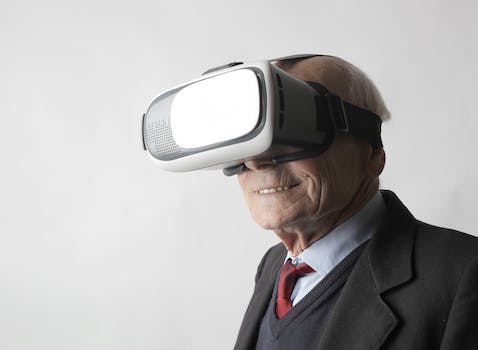
Virtual Reality (VR): Immersive Experiences and Applications
-
Table of Contents
- Introduction
- Exploring the Benefits of Virtual Reality for Education
- How Virtual Reality is Changing the Way We Experience Entertainment
- The Impact of Virtual Reality on the Gaming Industry
- The Future of Virtual Reality in Healthcare
- The Pros and Cons of Virtual Reality in the Workplace
- Q&A
- Conclusion
Beyond Reality.
Introduction
Virtual Reality (VR) is an immersive technology that has the potential to revolutionize the way we interact with the world. It is a computer-generated environment that allows users to experience a simulated reality, often with a sense of presence and immersion. VR can be used for a variety of applications, from gaming and entertainment to education and training. It can also be used to create virtual worlds and experiences that are not possible in the real world. With the advancement of technology, VR is becoming increasingly accessible and is being used in a variety of industries. From healthcare to engineering, VR is being used to create more efficient and effective solutions. With its potential to revolutionize the way we interact with the world, VR is an exciting technology that is sure to have a lasting impact on our lives.
Exploring the Benefits of Virtual Reality for Education
Virtual reality (VR) technology has been around for decades, but it has only recently become accessible to the general public. This technology has the potential to revolutionize the way we learn, and it is already being used in a variety of educational settings. In this blog post, we will explore the potential benefits of virtual reality for education.
First, virtual reality can provide a more immersive learning experience. By immersing students in a virtual environment, they can gain a better understanding of the material they are studying. For example, a student studying ancient history can explore a virtual version of an ancient city, or a student studying biology can explore a virtual version of a cell. This type of immersive learning can help students better understand and retain the material they are studying.
Second, virtual reality can provide a more engaging learning experience. By using virtual reality, students can interact with the material in a more engaging way. For example, a student studying chemistry can use virtual reality to explore the structure of molecules, or a student studying geography can explore a virtual version of a city. This type of interactive learning can help students stay engaged and motivated to learn.
Third, virtual reality can provide a more accessible learning experience. By using virtual reality, students can access educational materials from anywhere in the world. This can be especially beneficial for students in remote areas who may not have access to traditional educational resources.
Finally, virtual reality can provide a more cost-effective learning experience. By using virtual reality, educational institutions can save money on materials and resources. This can help make education more affordable and accessible to more people.
Virtual reality has the potential to revolutionize the way we learn, and it is already being used in a variety of educational settings. By providing a more immersive, engaging, accessible, and cost-effective learning experience, virtual reality can help students better understand and retain the material they are studying. As this technology continues to evolve, it is likely that we will see more and more educational institutions utilizing virtual reality in the future.
How Virtual Reality is Changing the Way We Experience Entertainment
Virtual reality (VR) is revolutionizing the way we experience entertainment. From gaming to movies, VR is transforming the way we interact with our favorite forms of entertainment.
VR gaming is one of the most popular applications of virtual reality. With the help of a headset, gamers can immerse themselves in a virtual world and interact with it in a way that was never before possible. VR gaming allows players to explore new worlds, interact with characters, and experience a level of immersion that was never before possible.
VR is also changing the way we experience movies. With the help of a headset, viewers can be transported into the world of the movie and experience it in a way that was never before possible. VR movies allow viewers to explore the world of the movie, interact with characters, and experience the story in a way that was never before possible.
VR is also changing the way we experience live events. With the help of a headset, viewers can be transported to the event and experience it in a way that was never before possible. VR live events allow viewers to explore the venue, interact with performers, and experience the event in a way that was never before possible.
VR is revolutionizing the way we experience entertainment. From gaming to movies to live events, VR is transforming the way we interact with our favorite forms of entertainment. With the help of a headset, viewers can be transported into the world of the entertainment and experience it in a way that was never before possible. VR is changing the way we experience entertainment and creating new possibilities for how we interact with our favorite forms of entertainment.
The Impact of Virtual Reality on the Gaming Industry

The gaming industry has seen a massive surge in popularity over the past few years, and virtual reality (VR) technology has been a major contributor to this growth. VR has revolutionized the gaming experience, allowing players to immerse themselves in a virtual world and interact with it in a way that was never before possible.
VR technology has been around for some time, but it has only recently become accessible to the average consumer. With the introduction of affordable headsets such as the Oculus Rift and HTC Vive, gamers can now experience a level of immersion that was previously only available to those with expensive gaming PCs. This has opened up the gaming industry to a whole new audience, and it has allowed developers to create more immersive and engaging experiences.
VR has also had a major impact on the way games are designed. Developers are now able to create games that are tailored to the VR experience, with features such as full body tracking and room-scale movement. This has allowed for more realistic and engaging gameplay, as well as a greater sense of presence in the virtual world.
The impact of VR on the gaming industry has been immense, and it is only going to continue to grow in the coming years. With more affordable headsets becoming available, and developers continuing to push the boundaries of what is possible with VR, the gaming industry is sure to continue to evolve and expand. It is an exciting time for gamers, and the future of gaming looks brighter than ever.
The Future of Virtual Reality in Healthcare
Virtual reality (VR) is quickly becoming a powerful tool in the healthcare industry. It has the potential to revolutionize the way healthcare professionals diagnose and treat patients, as well as how patients interact with their healthcare providers.
VR technology is already being used in a variety of ways in the healthcare industry. For example, it can be used to create immersive simulations of medical procedures, allowing healthcare professionals to practice and perfect their skills in a safe and controlled environment. It can also be used to create virtual environments for medical training, allowing students to gain experience in a realistic setting.
In addition, VR can be used to help patients with mental health issues. For example, it can be used to create virtual environments that allow patients to confront their fears and anxieties in a safe and controlled setting. It can also be used to help patients with physical disabilities, allowing them to practice physical activities in a virtual environment.
The potential applications of VR in healthcare are virtually limitless. In the future, it could be used to create virtual reality simulations of medical procedures, allowing healthcare professionals to practice and perfect their skills in a safe and controlled environment. It could also be used to create virtual environments for medical training, allowing students to gain experience in a realistic setting.
The possibilities for VR in healthcare are truly exciting. As the technology continues to evolve, it will open up new possibilities for healthcare professionals and patients alike. It is clear that VR has the potential to revolutionize the way healthcare is delivered, and it is only a matter of time before it becomes a standard part of the healthcare industry.
The Pros and Cons of Virtual Reality in the Workplace
Virtual reality (VR) is a rapidly growing technology that has the potential to revolutionize the workplace. It can be used to create immersive, interactive experiences that can help employees learn, collaborate, and innovate. However, there are both pros and cons to using VR in the workplace.
Pros
1. Enhanced Training: VR can be used to create immersive training experiences that can help employees learn more quickly and effectively. It can also be used to simulate dangerous or difficult tasks, allowing employees to practice in a safe environment.
2. Improved Collaboration: VR can be used to create virtual workspaces where employees can collaborate in real-time. This can help teams work together more efficiently and effectively.
3. Increased Productivity: VR can be used to create virtual workspaces that are optimized for productivity. This can help employees stay focused and get more done in less time.
Cons
1. Cost: VR technology can be expensive to purchase and maintain. This can be a barrier for smaller businesses that may not have the resources to invest in VR.
2. Privacy: VR can be used to create virtual workspaces that are accessible to anyone with the right technology. This can be a concern for businesses that need to protect sensitive information.
3. Health Risks: VR can cause motion sickness, eye strain, and other health issues. This can be a concern for businesses that need to ensure the safety of their employees.
Overall, virtual reality has the potential to revolutionize the workplace. However, businesses should carefully consider the pros and cons before investing in VR technology.
Q&A
Q1: What is Virtual Reality (VR)?
A1: Virtual Reality (VR) is a computer-generated simulation of a three-dimensional environment that can be interacted with in a seemingly real or physical way by a person using special electronic equipment, such as a headset with a screen or gloves fitted with sensors.
Q2: What are the benefits of using Virtual Reality (VR)?
A2: Virtual Reality (VR) can be used to create immersive experiences that can be used for entertainment, education, training, and more. It can also be used to create virtual environments for research and development, allowing users to explore and interact with a simulated environment.
Q3: What types of applications can be created with Virtual Reality (VR)?
A3: Virtual Reality (VR) can be used to create a wide range of applications, including gaming, virtual tours, medical simulations, virtual training, and more.
Q4: What hardware is needed to use Virtual Reality (VR)?
A4: To use Virtual Reality (VR), you will need a headset with a screen, such as an Oculus Rift or HTC Vive, as well as a computer or console to run the software. You may also need additional hardware, such as controllers or gloves, depending on the application.
Q5: What are some of the safety considerations when using Virtual Reality (VR)?
A5: When using Virtual Reality (VR), it is important to be aware of potential safety risks, such as motion sickness, disorientation, and eye strain. It is also important to take regular breaks and ensure that the environment is well-lit and comfortable.
Conclusion
In conclusion, Virtual Reality (VR) is an exciting and rapidly evolving technology that has the potential to revolutionize the way we interact with the world. It offers a unique and immersive experience that can be used for a variety of applications, from gaming and entertainment to education and training. As the technology continues to develop, we can expect to see more innovative and creative uses of VR in the future.






